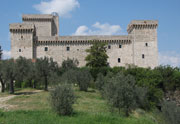 Narni: became in 299 b.C. roman colony after more than a year of siege which has undergone the console Fifth Appuleio Pansa, which, thanks to the treason of two local people the enabled the company to enter between the walls of the city, the latin name of Narnia. Main Event born in ancient times to celebrate the May 3 the festivities in honor of the patron saint Giovenale of Narni and the race to the ring The knights of the three terzieri of city Fraporta, Mezule and Santa Mari, compete in a race of horses in which they must slip with a spear a ring hanging small (last week of April second Sunday of May). To remember also the Narni Black Festival (from end august to first days of September) and Narnia Comics(first days of September). To visit in addition to the cathedral dedicated to its first bishop San Giovenale are the palazzo dei Priori, the Palazzo Comunale, the Rocca Albornoz and the Augustus Bridge (from the roman era built in the first century b.C., which rises to 30 meters above the river Nera).
Narni: became in 299 b.C. roman colony after more than a year of siege which has undergone the console Fifth Appuleio Pansa, which, thanks to the treason of two local people the enabled the company to enter between the walls of the city, the latin name of Narnia. Main Event born in ancient times to celebrate the May 3 the festivities in honor of the patron saint Giovenale of Narni and the race to the ring The knights of the three terzieri of city Fraporta, Mezule and Santa Mari, compete in a race of horses in which they must slip with a spear a ring hanging small (last week of April second Sunday of May). To remember also the Narni Black Festival (from end august to first days of September) and Narnia Comics(first days of September). To visit in addition to the cathedral dedicated to its first bishop San Giovenale are the palazzo dei Priori, the Palazzo Comunale, the Rocca Albornoz and the Augustus Bridge (from the roman era built in the first century b.C., which rises to 30 meters above the river Nera).
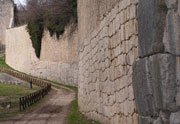 Amelia: placed on a hilly ridge interposed between the valley of the Tiber River and Black River, Amelia is the biggest center of "Amelia Area". Known in ancient times with the name of Ameria is a city of ancient origins boasts numerous testimonies of the past: in addition to the walls (formed in boulders perfectly stuck between them, sometimes very large, without the use of mortar), include the interesting old town with its numerous renaissance palaces, churches, remains of mosaics and spas.
Amelia: placed on a hilly ridge interposed between the valley of the Tiber River and Black River, Amelia is the biggest center of "Amelia Area". Known in ancient times with the name of Ameria is a city of ancient origins boasts numerous testimonies of the past: in addition to the walls (formed in boulders perfectly stuck between them, sometimes very large, without the use of mortar), include the interesting old town with its numerous renaissance palaces, churches, remains of mosaics and spas.
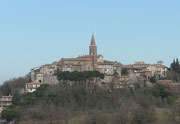 Montecastrilli: the parish church of S. Nicolò of fine workmanship, divided into six votive chapels, three of which are in baroque style. It preserves a wooden Crucifix from the 15th century, a canvas of Bartolomeo Poliziano(1629) depicting St. Anthony and St. Lucia , a Madonna del Rosario performed in 1606 by the painter Archiater Ricci of Urbino.
Montecastrilli: the parish church of S. Nicolò of fine workmanship, divided into six votive chapels, three of which are in baroque style. It preserves a wooden Crucifix from the 15th century, a canvas of Bartolomeo Poliziano(1629) depicting St. Anthony and St. Lucia , a Madonna del Rosario performed in 1606 by the painter Archiater Ricci of Urbino.
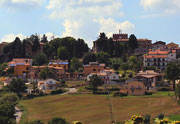 Avigliano Umbro: its territory was defined in 1975 when it became an autonomous municipality separating itself from Montecastrilli. To see the liberty style theater built in 1928 where it is held mainly in the month of June representations linked to projects of theater, cinema and communication. Don't miss the Fossil Forest of Dunarobba unique of its kind in Europe and the beautiful cave of Santa Restituta natural cavity located in an area pedemonte within a wooded area.
Avigliano Umbro: its territory was defined in 1975 when it became an autonomous municipality separating itself from Montecastrilli. To see the liberty style theater built in 1928 where it is held mainly in the month of June representations linked to projects of theater, cinema and communication. Don't miss the Fossil Forest of Dunarobba unique of its kind in Europe and the beautiful cave of Santa Restituta natural cavity located in an area pedemonte within a wooded area.




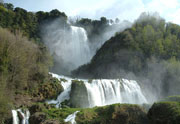 Terni: capital of the province and second city of Umbria is situated on the banks of the Nera river in a vast valley surrounded by the Appennino umbro-marchigiano and the Umbrian Sub-Appennino. It is nicknamed "The city of steel" for the steelworks were born in the 19th century with the industrial development making it fulcrum of the economy of Umbria and the Nation. Also known as the "City of Lovers" since San Valentino was Bishop and his mortal remains are kept in the Basilica of the city, the February 14 of each year take life events Valentiniani. For the entire month, in fact, is a succession of concerts, exhibitions, festivals, fairs and enriched by 2005 with the stand of Cioccolentino where chocolate is the tradition of pastry shops terni animate the streets of the City Center.
Terni: capital of the province and second city of Umbria is situated on the banks of the Nera river in a vast valley surrounded by the Appennino umbro-marchigiano and the Umbrian Sub-Appennino. It is nicknamed "The city of steel" for the steelworks were born in the 19th century with the industrial development making it fulcrum of the economy of Umbria and the Nation. Also known as the "City of Lovers" since San Valentino was Bishop and his mortal remains are kept in the Basilica of the city, the February 14 of each year take life events Valentiniani. For the entire month, in fact, is a succession of concerts, exhibitions, festivals, fairs and enriched by 2005 with the stand of Cioccolentino where chocolate is the tradition of pastry shops terni animate the streets of the City Center.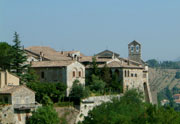 Sangemini: famous for its thermal baths and the homonymous brand of mineral water and especially for the beauty of well-preserved town center, characterized by typical medieval aspect. In the month of October on the occasion of the celebrations of the patron saint, St. Gemine, commemorated the October 9, begins in the event of the most popular in the country. On this occasion the two districts of Sangemini, the Fortress and the Piazza challenge in parades in medieval clothes that culminate with the "Giostra dell'Arme".
Sangemini: famous for its thermal baths and the homonymous brand of mineral water and especially for the beauty of well-preserved town center, characterized by typical medieval aspect. In the month of October on the occasion of the celebrations of the patron saint, St. Gemine, commemorated the October 9, begins in the event of the most popular in the country. On this occasion the two districts of Sangemini, the Fortress and the Piazza challenge in parades in medieval clothes that culminate with the "Giostra dell'Arme".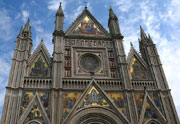 Orvieto: in the southwestern part of Umbria located on a tuff cliff 325 m.a.s.l. is located the city of Orvieto. Its origins have roots etruscan when in the 9th century b.C. was inhabited for the first time from these populations, which gave him the name of Velzna. Of considerable interest and the Duomo of Orvieto masterpiece of italian gothic architecture, whose façade is decorated with a great number of bassorilevi and sculptures made by the sienese architect Lorenzo Maitani and il Pozzo di San Patrizio(1528) deep 53 meters of cylindrical shape with a circular base with a diameter of 13 meters with two ramps helical in one direction only, with 248 steps and 70 windows which give light, make it a masterpiece of engineering. Events not to be missed are the Umbria Jazz Winter (between the end of december and the beginning of January), "Orvieto with taste" .( in the month of October), the "Festa della Palombella" (day of Pentecost) and the "Palio dell'Oca" (May).
Orvieto: in the southwestern part of Umbria located on a tuff cliff 325 m.a.s.l. is located the city of Orvieto. Its origins have roots etruscan when in the 9th century b.C. was inhabited for the first time from these populations, which gave him the name of Velzna. Of considerable interest and the Duomo of Orvieto masterpiece of italian gothic architecture, whose façade is decorated with a great number of bassorilevi and sculptures made by the sienese architect Lorenzo Maitani and il Pozzo di San Patrizio(1528) deep 53 meters of cylindrical shape with a circular base with a diameter of 13 meters with two ramps helical in one direction only, with 248 steps and 70 windows which give light, make it a masterpiece of engineering. Events not to be missed are the Umbria Jazz Winter (between the end of december and the beginning of January), "Orvieto with taste" .( in the month of October), the "Festa della Palombella" (day of Pentecost) and the "Palio dell'Oca" (May).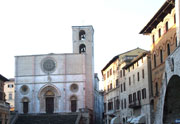 Todi: it is situated at the top of a hill, whose top is just slightly over 400 meters, overlooking the Tiber valley. Etruscan town, founded between the 8th and the 7th century b.C. by the Umbrians and given the name Tutere, which means "border Town", developed particularly between the 5th and 4th century bc, when, in 340 b.C., it became roman. The historical center, medieval, boasts sacred buildings of prestige as the Co-cathedral of the Santissima Annunziata, the church of San Fortunato and the convent of St. John the Baptist. Outside the walls is the famous renaissance church of Santa Maria della Consolazione. Of interest are also the fortress, with its 411 m a.s.l. And the highest point of the city. After several years, in 1503, was demolished by the will of Ludovico acts. Now remains of the fortress: a round tower, "the Donjon", ruins of fortification.
Todi: it is situated at the top of a hill, whose top is just slightly over 400 meters, overlooking the Tiber valley. Etruscan town, founded between the 8th and the 7th century b.C. by the Umbrians and given the name Tutere, which means "border Town", developed particularly between the 5th and 4th century bc, when, in 340 b.C., it became roman. The historical center, medieval, boasts sacred buildings of prestige as the Co-cathedral of the Santissima Annunziata, the church of San Fortunato and the convent of St. John the Baptist. Outside the walls is the famous renaissance church of Santa Maria della Consolazione. Of interest are also the fortress, with its 411 m a.s.l. And the highest point of the city. After several years, in 1503, was demolished by the will of Ludovico acts. Now remains of the fortress: a round tower, "the Donjon", ruins of fortification.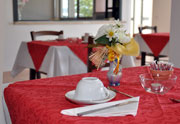 From September 17, 2011 to June 17, 2012 , offer for families: 2 adults + 2 children (up to 14 years) = 3 paying guests!
From September 17, 2011 to June 17, 2012 , offer for families: 2 adults + 2 children (up to 14 years) = 3 paying guests! 




